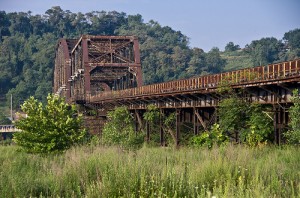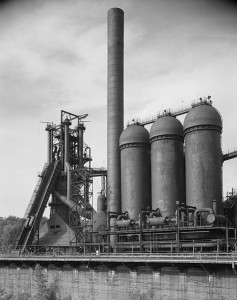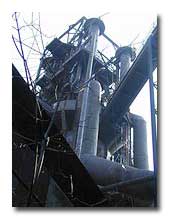
A few weeks ago, I had the opportunity to visit Carrie Furnaces, a National Historic Landmark in Rankin, Pennsylvania. From 1907-1978, the furnaces produced iron for U.S. Steel, as part of its massive Homestead Works complex. At its height during and immediately following World War II, the site employed more than 15,000 workers. Today, amazingly, little of the plant’s once gigantic footprint is left – at least above the surface. Indeed, aside from Carrie Furnaces # 6 and # 7, all that remains is a rather incongruous set of smokestacks positioned near the parking lot of a newly built shopping complex in Homestead. What was once arguably the center of American industrial production has, in the span of only a few decades, been rendered largely invisible, save for the important preservation and interpretation work now occurring at the Carrie site.

Carrie Furnaces is managed by the Rivers of Steel National Heritage Area (ROSNHA). ROSNHA also owns and has its headquarters in the Bost Building in Homestead, a former boarding house which served as the headquarters for striking steelworkers during the 1892 Battle of Homestead, a pivotal event in U.S. labor history. Ron Baraff, Director of Museum Collections & Archives for ROSNHA, led my tour, which was scheduled as part of the 2013 Pennsylvania Statewide Conference on Heritage. The visit offered a highly informative “behind-the-scenes” perspective on what it takes to stabilize and interpret a site as complex as an abandoned blast furnace.
One particular aspect of the contemporary Carrie Furnaces landscape that I would like to highlight is the treatment of natural resources. When the site was actively producing iron, little to no plant life grew in the area. Now, the opposite is almost true. Both native and invasive species have returned, creating an odd and somewhat riveting view-scape, where the steel and brick furnaces are juxtaposed against vibrant green leaves and vines.
At a panel presentation on industrial landscapes held during the conference, an attendee asked whether it might serve a better historical purpose to remove the vegetation at Carrie, so that visitors could gain a better idea of what the site looked like during its active period. With so much green, the questioner wondered, would a contemporary tourist lose perspective on what industrial Homestead might have looked like? Such an inquiry echoes debates often heard at other park and historic sites, such as removing trees from a Civil War battlefield or removing 19th century architecture from a historic park connected to the colonial period.

While I am sensitive to the question, especially as I personally dislike attempts to aestheticize abandoned industrial spaces, I think removing the plants would be a grave mistake (unless, of course, they are seriously harming the furnaces). Why? Because ruin, abandonment and environmental regeneration are all critical to the story of Homestead Steel and the Carrie site. While the period of significance for the National Historic Landmark designation may end in 1935 (strangely, the reviewers did not find it necessary or desirable to include the CIO organizing period, which marked the first time that mass production industries like steel had extensive union representation, though ROSNHA certainly discusses these important events) the landscape’s community significance and context continues to change and evolve and should not be held static. In its current state, Carrie viscerally communicates the rise and fall of much of American industry, as well as the shift to a service-based consumer society. It also can teach visitors about the ability of non-human nature to rebound from incredible stress, as well as the lasting impacts of pollutants to soil and water resources. Ruins are important, especially if they can be sensitively integrated and incorporated into ongoing community needs and wants. The Carrie Furnaces site is endeavoring to pursue just such an approach.


